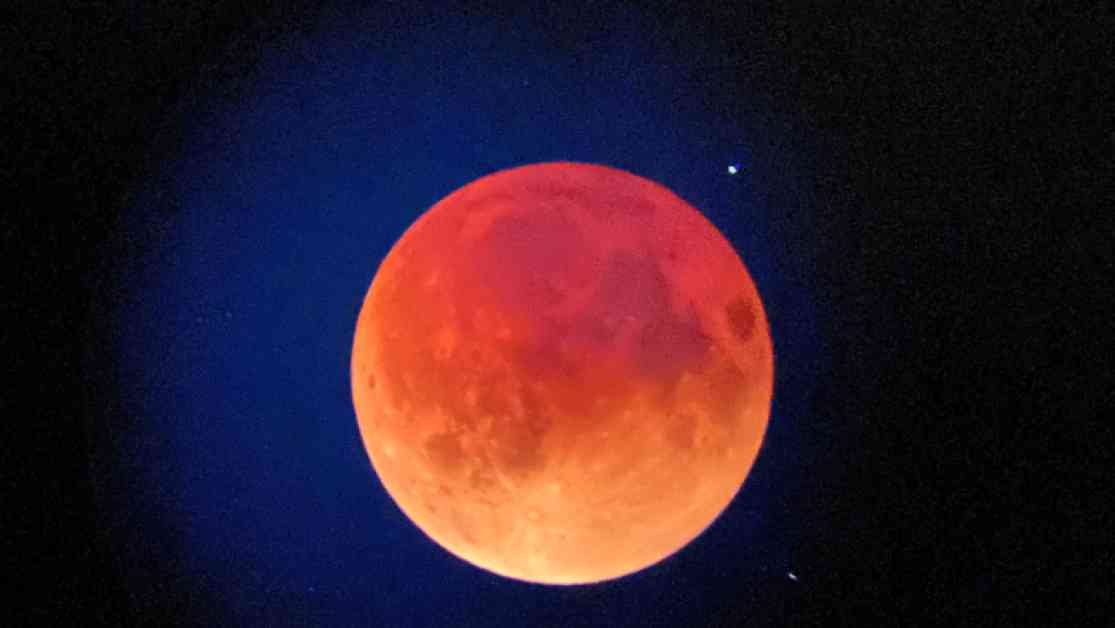Early Friday morning marks the first of two lunar eclipses this year, the only one visible in the U.S., presenting a rare opportunity to witness the celestial wonder of the blood moon. But for those hoping to catch a glimpse, a significant obstacle looms in the form of seriously cloudy skies.
The entire event spans over six hours, culminating in the captivating blood-red color on the moon visible during totality. To witness this striking phenomenon, one must wait until 2:26 a.m. when Earth’s shadow fully envelops the moon, with totality lasting until 3:31 a.m. The peak moment of the eclipse is set for 2:58 a.m.
Visibility prospects are dim for those east of the city, where predominantly cloudy skies are anticipated throughout the night. Yet, hope remains as a temporary break in the clouds between 2:30 a.m. and 3:30 a.m. could unveil the red moon. However, individuals residing further east on Long Island may find themselves under a blanket of overcast skies, challenging their chances of witnessing the eclipse firsthand.
For a clearer view, venturing north and west is recommended to escape the coastal cloud cover influenced by easterly winds. North Jersey and the Hudson Valley emerge as prime locations for unobstructed views of the lunar eclipse, offering better odds for an awe-inspiring experience under the night sky.
While the allure of the blood moon beckons, it is crucial to prepare for the harsh nighttime conditions. A jacket or sweatshirt is essential even in the relatively moderate temperatures of South Jersey, while the Hudson Valley promises freezing temperatures for those seeking an optimal viewing experience.
Looking ahead, the next lunar eclipse visible over NYC is slated for March 3, 2026, urging enthusiasts to seize the opportunity to witness the celestial spectacle firsthand.
### Understanding Lunar Eclipses
A lunar eclipse occurs when the sun, Earth, and moon align in such a way that the Earth’s shadow falls upon the moon. This celestial event contrasts with a total solar eclipse, where the moon obstructs the sun’s view from Earth. Lunar eclipses are relatively common, given the Earth’s larger size casting a substantial shadow for the moon to traverse. This phenomenon allows totality to be visible across vast regions, differing from the narrow path of totality characteristic of solar eclipses. As a result, multiple total lunar eclipses may occur in a single year compared to the infrequency of solar eclipses at the same location.
### Decoding the ‘Blood Moon’
During a lunar eclipse, the moon often takes on a reddish hue, earning the moniker “Blood Moon.” This crimson coloration results from the refraction of sunlight through Earth’s atmosphere onto the moon’s surface. As sunlight traverses the atmosphere, shorter wavelength colors like blue scatter out, leaving the longer wavelengths, predominantly red, to illuminate the moon during the eclipse. This atmospheric phenomenon mirrors the red hues witnessed during sunrise and sunset, where light must pass through an increased atmospheric depth, allowing red light to dominate the visual spectrum.
### Lunar Eclipse Viewing Tips and Future Events
Witnessing a lunar eclipse requires timely observation and clear skies rather than specialized equipment. The upcoming eclipse is set to peak before 3 a.m. on Friday, prompting enthusiasts to set early alarms for a chance to witness this celestial marvel. However, prevailing cloudy conditions pose a challenge to eclipse visibility, with forecasts indicating a high likelihood of obscured views.
As sky conditions remain uncertain, hopeful observers may opt to await the next lunar eclipse on March 3, 2026, for potentially clearer viewing opportunities and an enhanced celestial experience.












